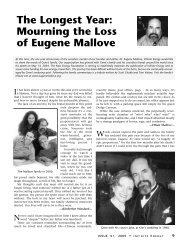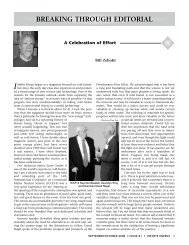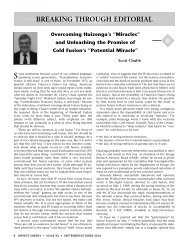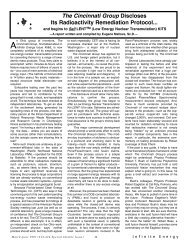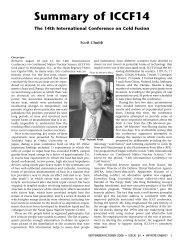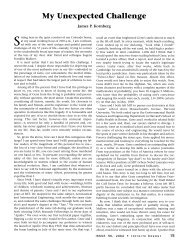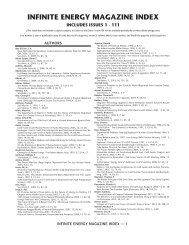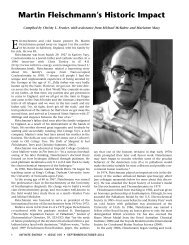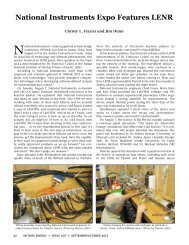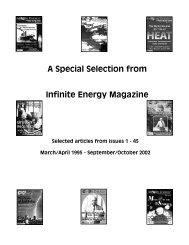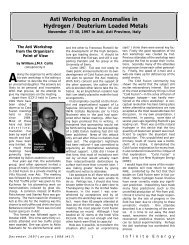MIT and Cold Fusion: A Special Report - Infinite Energy Magazine
MIT and Cold Fusion: A Special Report - Infinite Energy Magazine
MIT and Cold Fusion: A Special Report - Infinite Energy Magazine
Create successful ePaper yourself
Turn your PDF publications into a flip-book with our unique Google optimized e-Paper software.
a useful impression to give if one is trying to show that any possible<br />
excess power is within error bounds. It is inconceivable to me that these<br />
points were “inadvertently” put in. The only way that could have happened<br />
would have been if the time-calibration “data” were included<br />
erroneously in the purported algorithm that processed this data (which<br />
would then invalidate the entire purported “least squares” fit that Professor<br />
Parker has mentioned in one of his letters). These are dramatic<br />
outlying points that I believe may have been intentionally introduced.<br />
I hope that in view of the seriousness of Dr. Swartz’s findings, my<br />
assertions about them, <strong>and</strong> in the context of other major faults that I <strong>and</strong><br />
others have alleged about the <strong>MIT</strong> PFC publication, you will now act<br />
immediately. You could put in place a formal investigation of the entire<br />
matter with a panel of experts from both inside <strong>and</strong> outside <strong>MIT</strong>, which<br />
should include people both favorably disposed to cold fusion, <strong>and</strong><br />
those either not so disposed or neutral. But let me suggest that based<br />
on the facts that now appear so crystal clear, you should ask Professors<br />
Parker <strong>and</strong> Wrighton, who were the leaders of the research in question,<br />
to formally withdraw the entire “Phase-II” part of the Journal of <strong>Fusion</strong><br />
<strong>Energy</strong> published paper, <strong>and</strong> the corresponding part of the PFC/JA-89-<br />
34 report, <strong>and</strong> all conclusions that derive therefrom.<br />
I note that in the January 1992 issue of Physics Today, there is a news<br />
item (see attached) about the Council of the American Physical Society<br />
voting last November to adopt a set of guidelines “outlining professional<br />
conduct by physicists.” The text of the guidelines is printed <strong>and</strong><br />
contains several statements that I think are very pertinent to the PFC<br />
matter. One statement is: “Following publication the data should be<br />
retained for a reasonable period in order to be available promptly <strong>and</strong><br />
completely to responsible scientists. Exceptions may be appropriate in<br />
certain circumstances in order to preserve privacy, to assure patent protection,<br />
or for similar reasons.” The response of Professor Parker<br />
throughout this affair egregiously violates this guideline. For example,<br />
he has deliberately determined not to reveal the method of generating<br />
the heavy water curve of the “Phase-II” results.<br />
In my 24 October 1991 letter to you I specifically suggested that<br />
obtaining the algorithms that processed the data would be important.<br />
So did Professor Morrison in his 14 October 1991 memo to you: “They<br />
should also describe the two approaches to correction in more detail<br />
than the by-name-only account in the letter by Dr. Parker to Dr. Mallove<br />
of 8 August 1991.” In your 6 January letter to me you did not mention<br />
this key suggestion by Dr. Morrison, which I most certainly did not<br />
reject. Nor, as you stated in that letter, did I reject Professor Morrison’s<br />
suggestion “that [the] PFC should spend a personal day or two of work<br />
to compute the mean excess power for all four cases...” I must say, you<br />
have inadvertently twisted the interpretation of one brief phrase that I<br />
wrote, “..in regretted disagreement with the recommendations of Professor<br />
Morrison..”, which was made in the context of a request for a<br />
much more complete investigation, to imply that I did not want to see<br />
those alleged PFC algorithms or have the means computed.<br />
Another guideline that the APS Council put forth also has direct<br />
application to the matter at h<strong>and</strong>: “Fabrication of data or selective<br />
reporting of data with the intent to mislead or deceive is an egregious<br />
departure from the expected norms of scientific conduct, as is the theft<br />
of data or research results from others.”<br />
In the issue of Tech Talk dated 5 February 1992 is published the <strong>MIT</strong><br />
procedures for dealing with “Academic Fraud in Research <strong>and</strong> Scholarship.”<br />
The statement is made: “In addition, the Provost has the authority<br />
to mitigate the effects of the fraud by withdrawing <strong>MIT</strong>’s name <strong>and</strong><br />
sponsorship from pending abstracts <strong>and</strong> papers <strong>and</strong> by notifying persons<br />
known to have relied upon any work affected by fraud.” I expect<br />
that this will be carried out for the matter at h<strong>and</strong> once the final determination<br />
has been made.<br />
I note further in the <strong>MIT</strong>-published statement: “An inquiry must be<br />
initiated immediately after an allegation has been made <strong>and</strong> must be<br />
completed within 60 calendar days of its initiation unless circumstances<br />
clearly warrant a longer period. If the inquiry takes longer than 60 days,<br />
the record of the inquiry shall include documentation of the reasons for<br />
exceeding the 60 day period.” My initial request for an inquiry <strong>and</strong> possible<br />
investigation was submitted on 18 August 1991. There have been<br />
a number of written exchanges between us, including my 31 December<br />
1991 letter in which I asked about the status of your inquiry, following<br />
my earlier letter of 24 October. Your letter of 8 January 1992 seemed to<br />
terminate the matter as far as you were concerned. Thus, more than 140<br />
days have gone by in which only one <strong>MIT</strong> faculty member, Professor<br />
Morrison, spent part of October 13 <strong>and</strong> October 14 reviewing (incompletely)<br />
my requests. After October 24, but perhaps as late as the first<br />
week of January 1992, Professor Litster, the Associate Provost to Provost<br />
Mark Wrighton (one of the authors of the questioned research) “independently”<br />
reviewed the matter <strong>and</strong> “confirmed Professor Morrison’s<br />
conclusion that there is no basis for further investigation of the charges<br />
of scientific misconduct.”<br />
In your 8 January 1992 letter you wrote, “I have considered, <strong>and</strong><br />
sought advice from legal counsel, on whether it was necessary or appropriate<br />
for me to investigate your charges of bias in dealing with the<br />
media, <strong>and</strong> I have concluded that it is neither necessary nor appropriate<br />
for me to do so.” Please go back <strong>and</strong> read my 18 August request for an<br />
investigation, because you have again inadvertently twisted my position.<br />
I was not <strong>and</strong> am not concerned about “bias in dealing with the<br />
media.” Bias in dealing with the news media (such as selecting which<br />
newspaper one wants to favor with an interview) is precisely the objective<br />
<strong>and</strong> accepted (if not altogether proper!) role of a news office; I have<br />
no objection to such “bias.” What I was talking about in my request was<br />
the investigation of giving false information in matters that are not<br />
small—giving false information to me to prepare an erroneous new<br />
release, giving false information to others in the News Office, <strong>and</strong> giving<br />
false information to the greater world about what was said to a<br />
reporter. In other words, a calculated attempt to discredit that reporter<br />
<strong>and</strong> newspaper by giving false information. Moreover, a denial of giving<br />
this false information persists. Do you not think it is time to do<br />
something about that? Is this level of expected personal integrity no<br />
longer important at <strong>MIT</strong>?<br />
In summary, I consider that the inordinately extended inquiry up to<br />
this point has not met <strong>MIT</strong>’s own proclaimed st<strong>and</strong>ards. I hope that in<br />
light of the newly developed information, this time you will underst<strong>and</strong><br />
my points quite clearly. This is a very grave matter which has in my<br />
view, I regret to say, already damaged <strong>MIT</strong>. You cannot sweep research<br />
fraud under the rug -- even if it is in the context of a claimed phenomenon<br />
with which you, Provost Wrighton, <strong>and</strong> several others at <strong>MIT</strong> have<br />
little patience. If you do not do the necessary investigative job yourself,<br />
I am convinced that others inevitably will.<br />
I am also sending a copy of this letter to my former associate, Kenneth<br />
Campbell of the <strong>MIT</strong> News Office, because I know he is familiar<br />
with the ramifications of this type of situation, having witnessed, as did<br />
I, another well-known controversy that did not help the image of <strong>MIT</strong>.<br />
cc: Kenneth Campbell<br />
Sincerely, Eugene F. Mallove<br />
Exhibit Z-2<br />
Eugene Mallove’s Letter to President Charles Vest<br />
February 21, 1992<br />
President Charles M. Vest, <strong>MIT</strong> Room 3-208<br />
Dear Dr. Vest:<br />
On February 10 you received a letter from me that discussed a serious<br />
issue connected with research at <strong>MIT</strong>. Have you initiated any<br />
actions on this matter? When might I expect a reply from your office?<br />
Sincerely, Eugene F. Mallove<br />
cc: Kenneth Campbell [<strong>MIT</strong> News Office]<br />
Exhibit Z-3<br />
Dr. Stanley Luckhardt’s Letter to Professor Morrison<br />
March 10, 1992<br />
While President Vest continues to stonewall, a congenial<br />
memo is passed between Dr. Luckhardt (who<br />
still has control of the contested data) <strong>and</strong> Prof. Morrison—some<br />
“investigation”! Of course, this concerns<br />
the “discredited” cold fusion, so it is not important<br />
for <strong>MIT</strong> to observe the usual st<strong>and</strong>ards.—EFM<br />
Plasma <strong>Fusion</strong> Center<br />
Massachusetts Institute of Technology<br />
MEMO<br />
Dr. Luckhardt<br />
<strong>MIT</strong> News Photo<br />
51 <strong>Infinite</strong> <strong>Energy</strong> • ISSUE 24, 1999 • <strong>MIT</strong> <strong>Special</strong> <strong>Report</strong>



